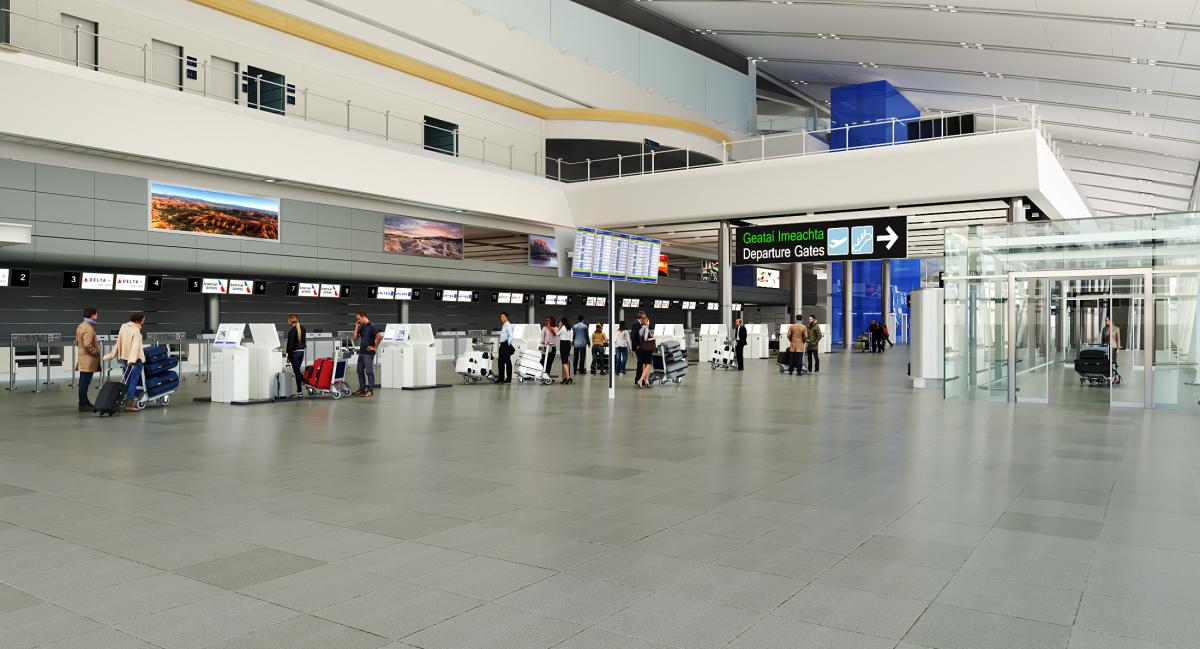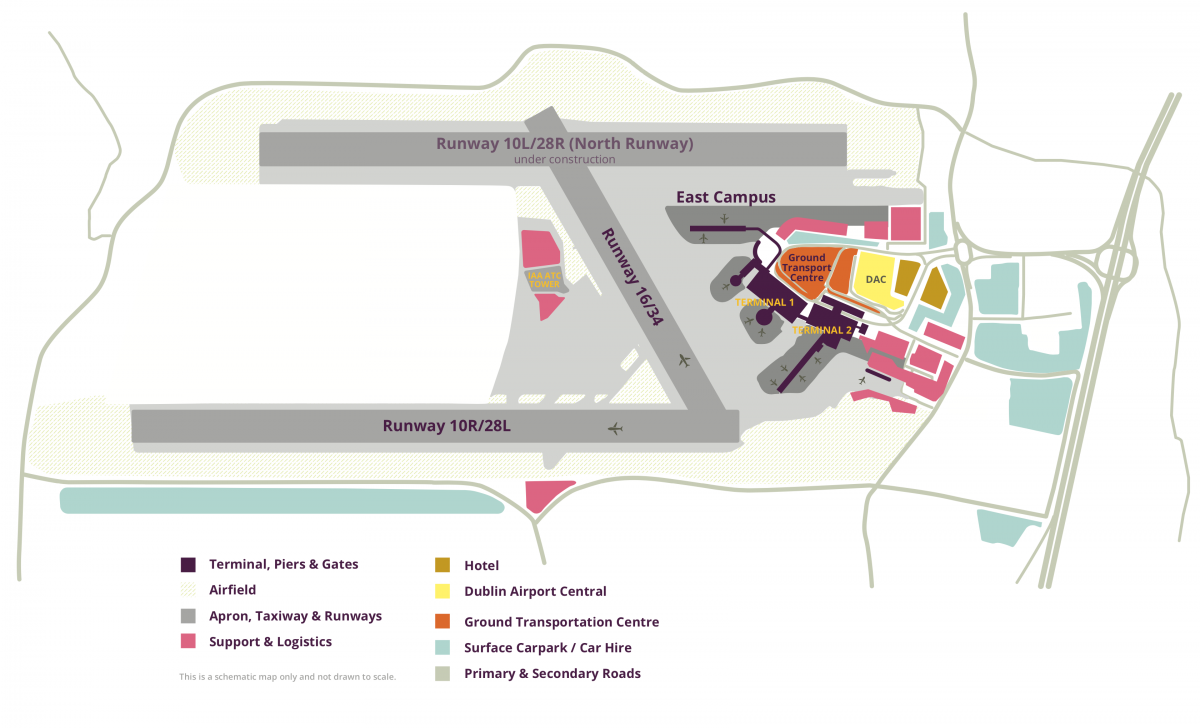2.2 Dublin Airport’s infrastructure

Airports are divided into landside and airside areas with various components of landside and airside infrastructure. The landside area is open to the public, while access to the airside area is tightly controlled. Specifically, landside is the area(s) at an airport before passengers go through security, customs, and immigration including the landside access road network and public transport. Dublin Airport’s infrastructure has continued to evolve over a number of decades incorporating the various landside and airside components as set out in Figure 2.3. The existing runway configuration delineates the Airport lands into eastern and western campus areas with the main terminal buildings located in the eastern campus. Definitions of specific core landside and airside infrastructure components are provided in the context of Chapter 3 Forecasts and Capacity Constraints. The current existing infrastructure at Dublin Airport are summarised under the following:
2.2.1 LANDSIDE INFRASTRUCTURE
-
Surface Transport Network, comprising the strategic external road and public transport access to and from the Airport, the internal road and public transport network centred on the Ground Transportation Centre comprising various pick-up and set down areas and bus and coach boarding facilities, short-term multi-storey car parks adjacent to Terminals 1 and 2, taxi facilities adjacent to Terminals 1 and 2, car hire, staff-parking and long-stay car-parking areas.
-
Passenger terminal Operations in Terminal 1 (T1) and Terminal 2 (T2) comprising check-in, security, airline lounges, baggage reclaim, immigration, border controls, US preclearance in T2 and supporting retail.
-
Ancillary aviation related facilities comprising airport light industrial and warehousing accommodation for catering and logistics companies, offices for airlines and a range of other airport-based service suppliers and contractors and hotels.
-
Airport based commercial development comprises commercial development that has no direct need to be at an airport but is attracted to it as a well-connected and attractive business location (e.g. offices, logistics, light industry), but would typically exclude non-airport retail, commercial leisure and residential development.
2.2.2 AIRSIDE INFRASTRUCTURE
-
Runways (runway 10R/28L and runway 16/34 existing & runway 10L/28R which is under construction), aircraft taxiways, Rapid Exit Taxiways (RET’s), aprons and supporting navigational aids and associated airfield ground support facilities.
-
Aircraft parking stands and associated piers and passenger boarding gates.
-
Maintenance Repair and Overhaul-MR0 Facilities.
-
Cargo Facilities.
-
Other airside development comprising air traffic control, fire and rescue facilities, fuel farm, power plant, waste processing and other utility buildings.
2.2.3 CARGO INFRASTRUCTURE
Currently, there are no dedicated contact stands for cargo aircraft and no single dedicated handling facility in place at Dublin Airport with cargo planes parked remotely, west of runway 16/34. The only exception is the IAG cargo facility located to the south of T2 which is separate from those of express freight carriers like DHL and UPS. Air cargo operations support Ireland’s economy by facilitating the movement of traded goods into and out of the Country. The high value-adding life-sciences sector (pharmaceuticals, medical devices) in Ireland is particularly reliant on airfreight services for the movement of products between Ireland and the US. This in turn is reflected in the very high value-to weight ratio of airfreight which accounts for about 35% of all Irish merchandise exports by value.23
Ireland’s main airports24 handled a total of 157,364 tonnes of freight in 2018, the vast majority (93.6%) which was international freight. Dublin Airport plays a significant role in terms of the movement of freight from Ireland. As much as 90% of the total air freight handled in 2018 arrived or departed Ireland through Dublin Airport.25 Analysis of air freight handled by Ireland’s state airports26 indicates that 40% travels on dedicated air cargo flights and the remaining 60% is carried in the cargo bay of passenger aircraft and is known as “bellyhold” cargo.27 Dublin Airport’s role in freight movement may become even more important in light of Brexit if the ability of Irish exporters to utilise the UK as a land bridge to continental European markets becomes constrained.
2.2.4 MAINTENANCE REPAIR AND OVERHAUL (MR0) INFRASTRUCTURE
Maintenance Repair and Overhaul (MRO) facilities currently include an Auxillary Power Unit [APU] overhaul centre28, a landing gear service centre, aircraft overhaul and aircraft painting facilities located airside and to the north of the main terminal facilities. The availability of MRO maintenance at Dublin will continue to be necessary, particularly as the Airport continues to grow.
2.2.5 RECENT STRATEGIC AIRPORT INFRASTRUCTURE PROJECTS
Recent strategic infrastructure projects at Dublin Airport include, the existing runway 10R/28L overlay re-surfacing, airfield lighting upgrade, taxiway airfield ground lighting upgrade and enhancements to Pier 4 to accommodate expanded US pre-clearance facilities. In addition, a new Air Traffic Control Tower is nearing completion and the north runway 10L/28R is currently under construction.

Figure 2.3 - Dublin Airport’s current infrastructure
- 23 - A National Aviation Policy for Ireland 2015.
- 24 - Dublin, Cork, Shannon, Kerry and Knock.
- 25 - CSO 2018 – Aviation Statistics.
- 26 - Dublin, Cork and Shannon.
- 27 - Oxford Economics for DTTAS: Review of the Capacity Needs of Ireland’s Airports (August 2018).
- 28 - APU–Provision of overhaul repair and modification services for Auxiliary Power Units –APU (eg. aircraft electrical power and air conditioning services).